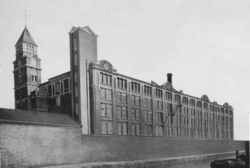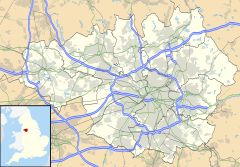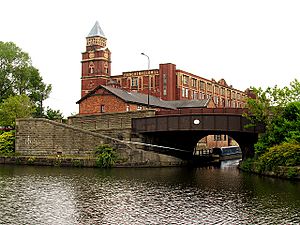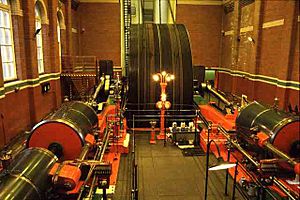Trencherfield Mill facts for kids

Trencherfield mill before 1951
|
|
| Cotton | |
|---|---|
| Spinning (ring mill) | |
| Location | Wigan Pier, Wigan, Greater Manchester, England |
| Serving canal | Leeds and Liverpool Canal |
| Further ownership |
|
| Coordinates | 53°32′28″N 2°38′16″W / 53.5411°N 2.6378°W |
| Construction | |
| Completed | 1907 |
| Power | |
| Date | 1907 |
| Engine maker | J & E Wood |
| Decommissioned | Still in steam |
| Engine type | triple-expansion four-cylinder engine |
| Valve Gear | Corliss valves |
| Cylinder diameter and throw | 25"HP, 40"IP, two 44"LP X 5ft |
| rpm | 68 |
| Installed horse power (ihp) | 2500 |
| Flywheel diameter | 26ft |
| Transmission type | ropes |
| No. of ropes | 54 |
Trencherfield Mill is a large cotton spinning mill located next to the Leeds and Liverpool Canal in Wigan, Greater Manchester, England. It was built in 1907. This mill was once a very important place for making cotton thread.
Big companies like the Lancashire Cotton Corporation and Courtaulds owned the mill over the years. A huge 2,500 horsepower steam engine, built by J & E Wood of Bolton, powered the mill. This amazing engine had two main parts named Rina and Helen! They turned a giant 26-foot wheel with 54 ropes, spinning at 68 times a minute. The engine stopped working in 1968.
Today, Trencherfield Mill is part of the famous Wigan Pier area. It has been updated and is now used for different things, like homes and businesses.
Contents
Where is Trencherfield Mill?
Trencherfield Mill is in Wigan, a town in Greater Manchester, England. Wigan is about 15 miles (24 km) south of Preston and 16.5 miles (26.5 km) west-northwest of Manchester. The town is located on the River Douglas.
The mill stands right by Wigan Pier, which is a wharf (a place where boats load and unload) on the Leeds and Liverpool Canal. Wigan Pier became famous because of a writer named George Orwell. He wrote a book called The Road to Wigan Pier, which talked about the tough lives of people in the area during the 1930s.
History of the Mill
Wigan has a long history, especially during the Industrial Revolution. This was a time when new machines and factories changed how people worked and lived. Wigan became a major town for making textiles (like cloth) and for coal mining.
The first coal mine in Wigan opened way back in 1450! At one point, there were over 1,000 coal mine shafts within 5 miles (8 km) of the town centre. Mining was so common that people sometimes had a coal mine in their own backyard! Coal mining stopped in the late 1900s.
How Wigan Became a Mill Town
Because Wigan had a lot of coal and was good for engineering, people built canals to move goods. The Douglas Navigation was built in the 1740s, and later the Leeds and Liverpool Canal was changed to go through Wigan in the 1790s. This helped transport coal to the mills and other local products.
Even though Wigan was important for textiles, cotton factories didn't really spread there until the 1800s. This was because the area didn't have many fast-flowing rivers to power early mills. But by 1818, there were eight cotton mills in one part of Wigan. That same year, William Woods brought the first power looms (machines that weave cloth) to Wigan's cotton mills.
Trencherfield Mill was built next to the canal in 1907 for William Woods & Sons Ltd. It was the largest mill built in Wigan at that time and the last one to be built with direct access to the canal.
Changes Over Time
The cotton industry was at its busiest in 1912. But then, World War I (1914–1918) made it hard to get raw cotton. The British government encouraged other countries to build their own mills. After the war, Lancashire (the region where Wigan is) never got back all its old markets.
Many independent mills struggled. So, in 1929, the Bank of England created the Lancashire Cotton Corporation (LCC) to try and save the industry. Trencherfield Mill was one of 104 mills bought by the LCC, and it was one of the 53 mills that kept going until 1950.
The mill finally closed in 1968, and 350 people lost their jobs.
Mill Restoration and New Uses
In 1984, Wigan Council took over the mill's amazing steam engine. They fixed it up as part of the Wigan Pier redevelopment. Even Queen Elizabeth II visited the engine in March 1986 when the "Way We Were" heritage complex at Wigan Pier officially opened.
Between 2005 and 2007, the old mill building was renovated. This was a big part of the Wigan Pier regeneration project. Money from different funds helped restore many sites in the area. Trencherfield Mill became a place with shops, offices, and 52 apartments.
The mill's 2,500 horsepower steam engine was saved and restored. As of 2025, you can still see it working on special dates throughout the year!
For a while, Trencherfield Mill was home to The Mill at the Pier, an arts and performance venue. It also hosted the Wigan International Jazz Festival. Later, a famous British drama school, ALRA North, used the mill from 2012 until 2022. The mill is also used as a call centre for companies like EE and BT.
Mill Design
The Trencherfield Mill we see today was built in 1907. It was the third mill on this site. The first one was built in 1822–23 by William Woods. This site was special because it had the first power looms in Wigan.
The 1907 mill was very large, with four floors and a basement. Its tall, round chimney is a notable feature. The design of the mill's tower, located near the canal, was inspired by the famous St Mark's Campanile in Venice, Italy. This Venetian tower inspired similar designs around the world.
Mill Power
The mill was powered by a huge 2,500 horsepower steam engine built by J & E Wood of Bolton in 1907. As mentioned, the two main parts of the engine are named Rina and Helen. They turn a giant 26-foot flywheel using 54 ropes, spinning at 68 times a minute.
This engine is a "triple-expansion four-cylinder" type. It has different sized cylinders that help it use steam very efficiently. It also uses special Corliss valves to control the steam flow.
Today, this amazing steam engine has been fully restored. It's a popular visitor attraction, and engineers give tours on certain days each year, showing how it works.
See also
- Listed buildings in Wigan
- Textile manufacturing




